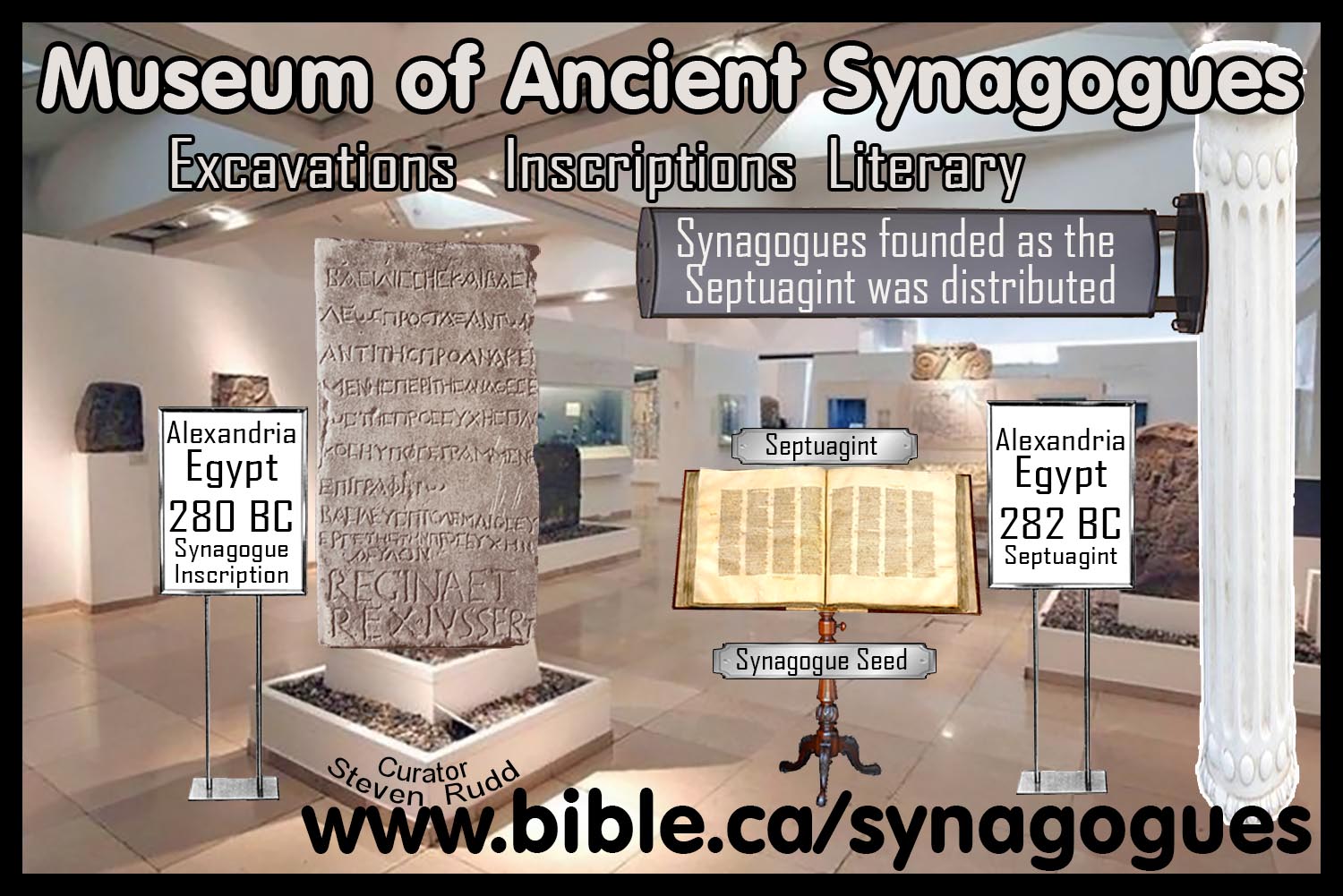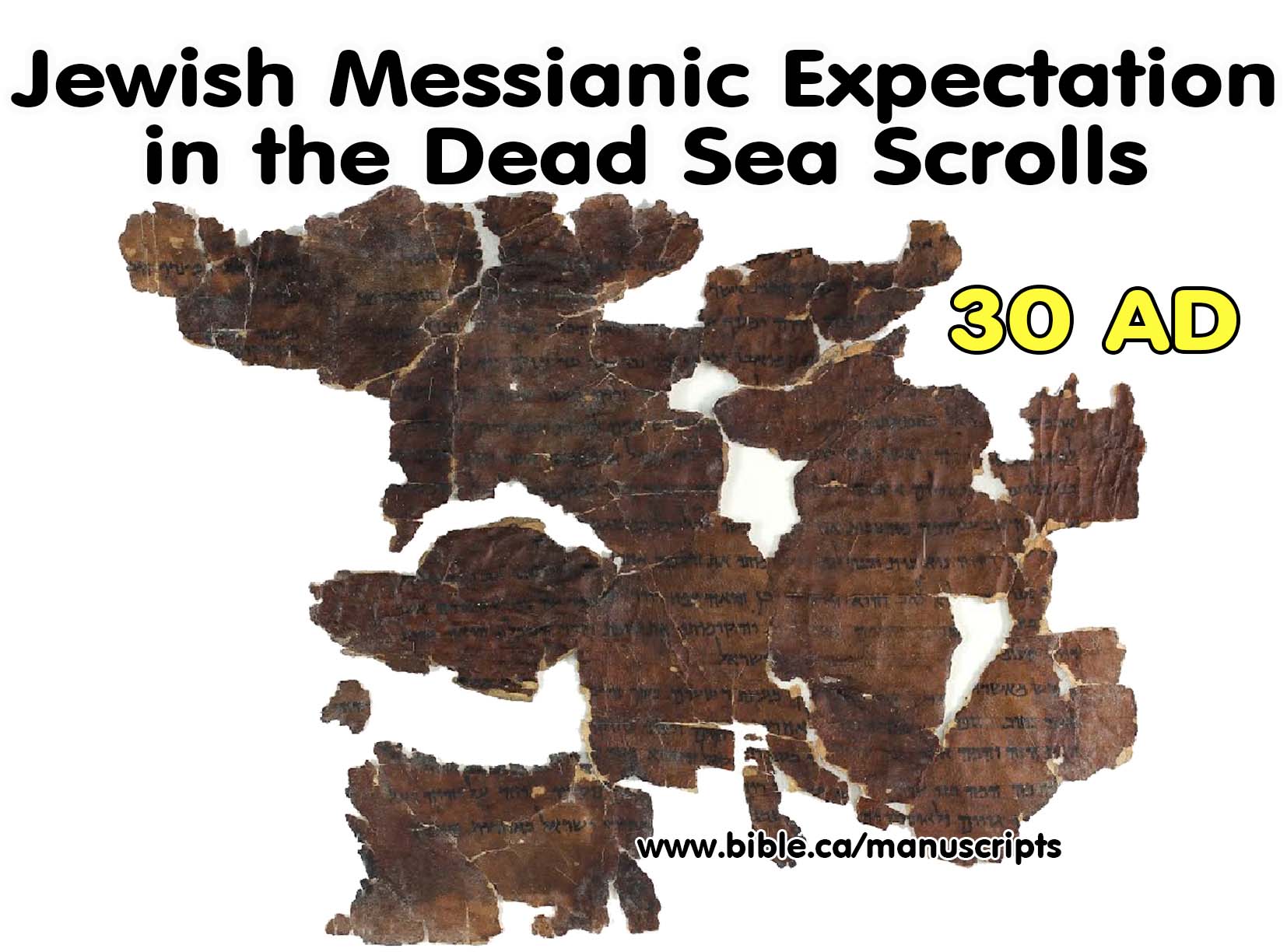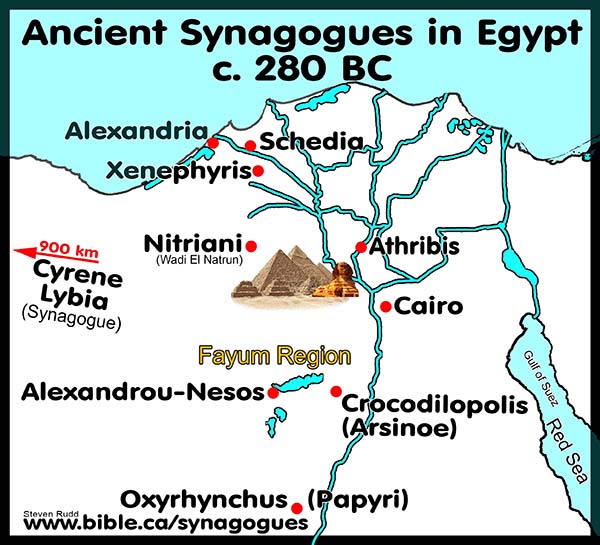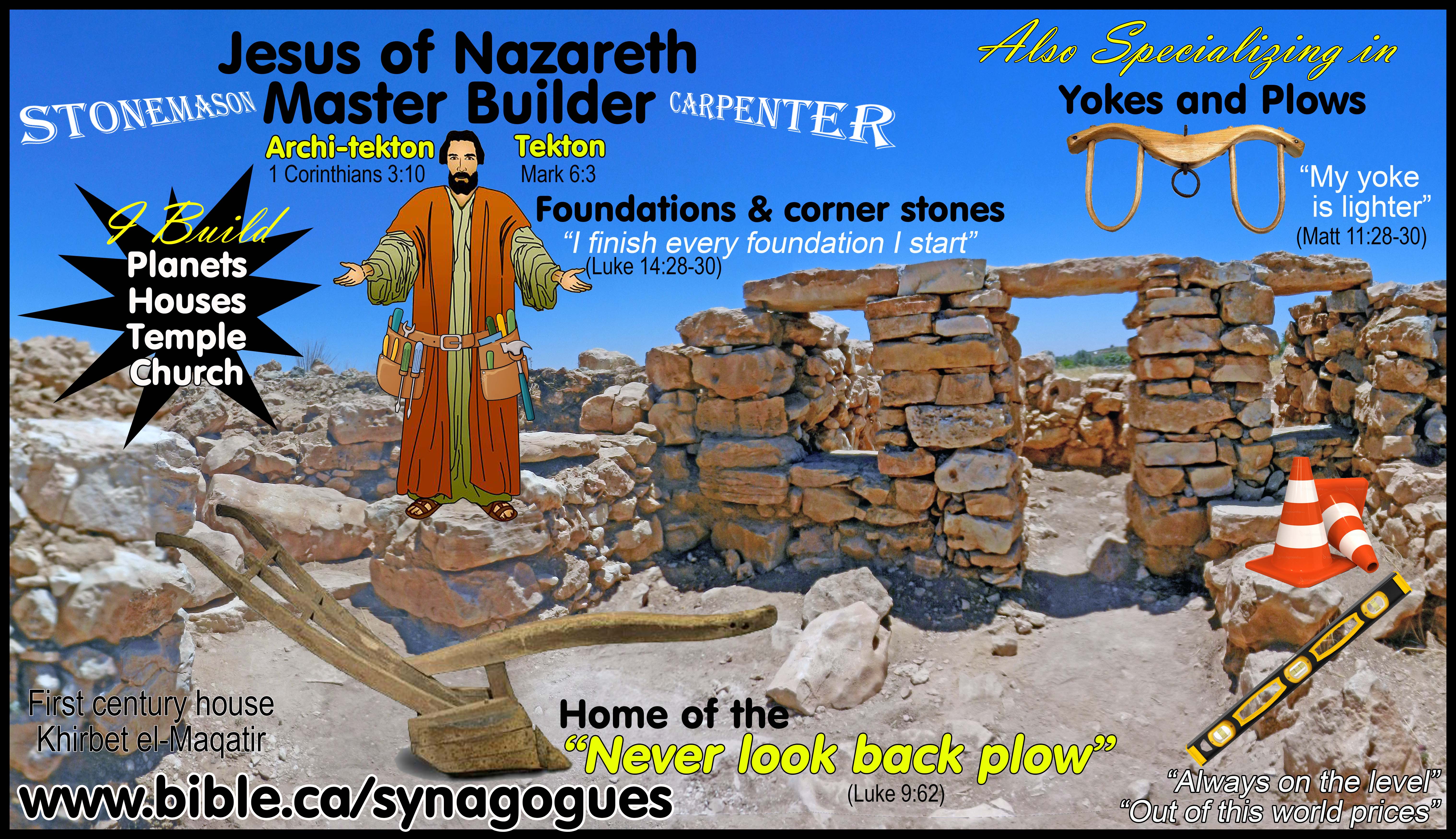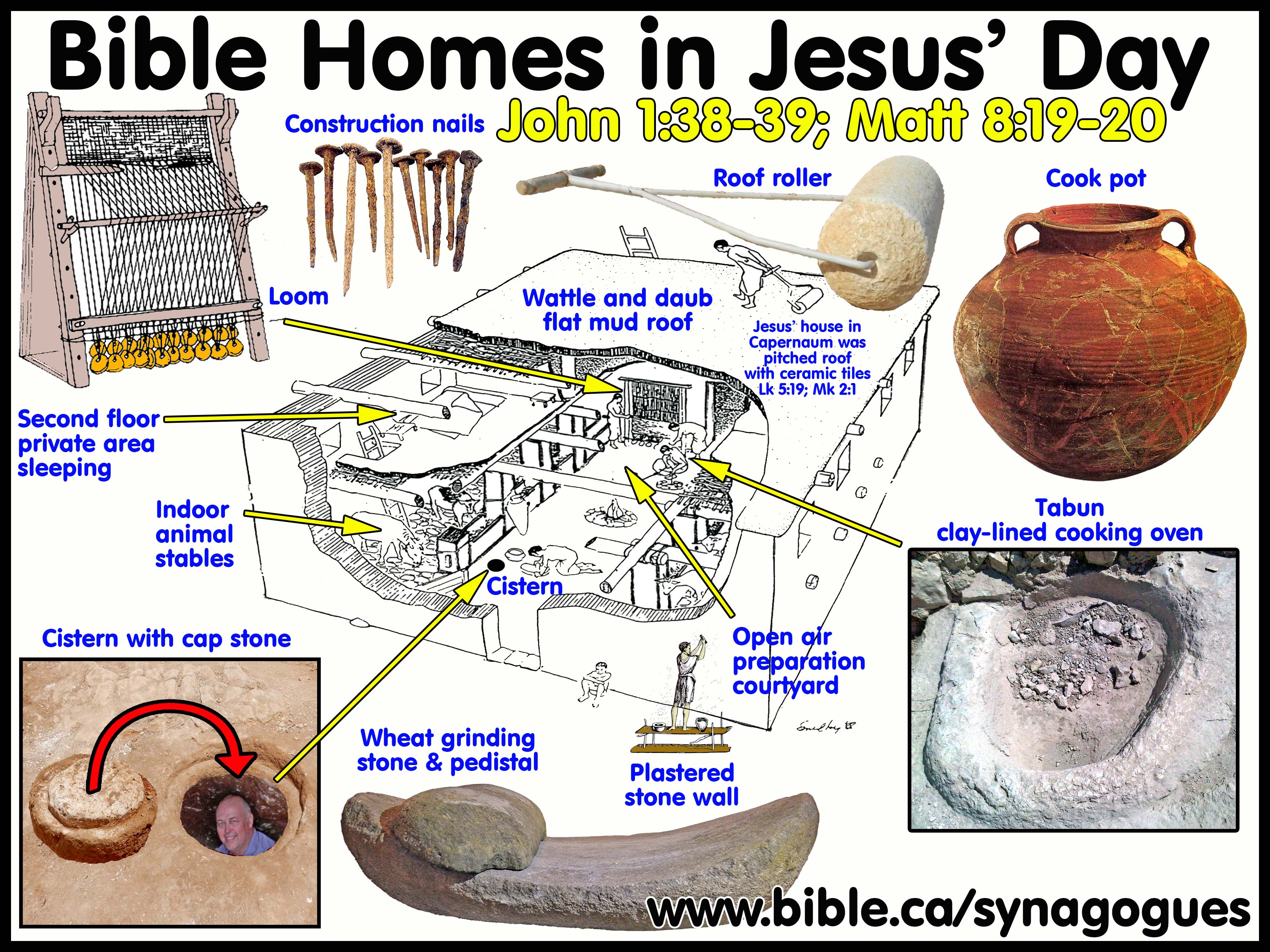First Century Synagogue Top Plans: Gush Halav, Gischala 78 BC
Archeological Excavations of Oldest Synagogues in the world
|
Gush Halav (Gischala) 78 BC |
Click on photos for high resolution
Introduction:
1. Gush Halav is known in Josephus as Gischala and is located north west of the sea of Galilee.
2. Home of Revolt leader John of Gischala who was later captured in Jerusalem and paraded by Titus in Rome in the great processional: Jos. W. 7.118
3. The first century synagogue (not pictured here) is on the top of the hill under a church that was built on top of its remains.
a. “Surveys made at the end of the 19th and early 20th century revealed the remains of two synagogues. The village church was built over the remains of one which stands at the highest point on the hill. The other built of large carefully dressed blocks and in a better state of preservation, is beautifully situated near the village spring, overlooking a green valley. The inner dimensions of the building are 46 feet by 50 feet. It had an inner colonnade on three sides of the hall, of which the stylobate and some bases and column drums still remain in position. The main entrance to the building was on the south, the side facing Jerusalem, and was decorated with architectural motifs. Lining the long walls were stone benches to seat the congregation. The lintel of the main entrance, on which an eagle was depicted between wreaths, was found in the debris. On one of the column drums was a Hebrew inscription reading: ‘Jose son of Tanhum made this shrine. Let him be blessed.’ Both buildings are among the early group of synagogues (i.e. they date from the 2nd–3rd centuries AD). The site is identified with el-Jish in Upper Galilee.” (The Archaeological Encyclopedia of the Holy Land, Gush-Halav)
b. A church was built on top of remains of a second synagogue on the city hilltop.
c. There are two stages to the church: an early structure in 250 AD and a later structure around 330 AD due to earthquake.
d. The excavators found fragments of two heart-shaped columns with two matching capitals whose original location was uncertain. They were placed on the later bema in their drawings. These two special columns could date back to the first century when they were used as in Gamla.
A. Earliest Synagogue Occupation Date (SOD) = 78 BC
1. Excavation date: first century
2. Inscriptional date: none
3. Literary date: Josephus 78 BC
4. SOD computation system details: Excavation date + Inscriptional date + Literary date = SOD.
B. Synagogue Compass Orientation:
1. Orientation East or towards Jerusalem: No.
a. Following the same pattern as Gamla, Gush Halav had a bema that did not face Jerusalem and an Ark of the Scroll located immediately on the left side at the entrance of the Synagogue.
2. Compass headings:
a. Compass heading towards Jerusalem: 189 Degrees.
b. Distance to Jerusalem: 140 Kilometers.
3. When an archeologist begins excavating a newly discovered synagogue, the first thing he does to determine if it is a first temple, pre-70 AD installation is determine the orientation.
a. If the synagogue points east it is not pre-70 AD but built after 200 AD.
b. If the synagogue is oriented towards Jerusalem it is not pre-70 AD but built after 200 AD.
4. See Orientation: Early Synagogues did not Point to Jerusalem
C. Bible and other Literary references:
1. “A [A house in a city] the roofs of which form its wall, B or one in a city which was not surrounded by a wall from the time of Joshua ben Nun, C is not deemed a dwelling house in a walled city. D And what is a dwelling house in a walled city? E [A city in which are not less than] three courtyards, each with two houses, surrounded by a wall from the time of Joshua ben Nun, F such as: I the old castle of Sepphoris; 2. the fortress of Gush Halab, 3. old Yodpat, 4. Gamala, 5. Gadwad, 6. Hadid, 7. Ono, 8. Jerusalem, 9. and the like.” (Mishna, m. 'Arak. 9:6)
D. Excavation details:
1. Pitched roof with Ceramic Roman tiles:
a. The house of Jesus at Capernaum also had ceramic roof tiles.
b.
See also: Fired clay roofing tiles: Archeology of Everyday Life and Homes at the time of
Jesus

2. The Bema:
a. See also: The bema: Prototype of the Church Pulpit
b.
“Other synagogues, at Khirbet Shema and Gush Halav, had a bima against
the southern wall” (The Ancient Synagogue, Lee Levine, p195, 1999 AD)

3. Ark of the scrolls wooden cabinet:
a. See also: Niches & Ark of The Scrolls: Prototype of Church Apse
b.
The Torah Shrine, would sit on the bema near the door.

4. Heart shaped columns:
a. See also: Artwork: Heart-Shaped Columns
b.
“The interior was divided into a nave and two
aisles by two rows of four columns each. The columns stood on stylobates of
dressed ashlars which are parallel to the two north-south walls. Though the
pedestals for the columns are virtually identical in form, their dimensions
vary. Similarly, the column fragments recovered in the excavations vary in
dimension, and the seven capitals recovered differ in style. There are also fragments of two heart-shaped columns with two
matching capitals, whose placement within and association with the synagogue is
uncertain. Other architectural features discovered inside the synagogue
include fieldstone benches along the western and northern walls. and a bema
(or, according to the excavators, two consecutive bemas), against the south
wall to the west of the doorway. The small number of tesserae found in the
fills of the synagogue suggests that the floor was not tessellated.” (The
question of the synagogue: the problem of typology" in Judaism in Late
Antiquity III, Where we Stand: issues and debates in Ancient Judaism, Jodi
Magness, Vol 4, Neusner, p1-48, 2001 AD)

5. Hoard of coins:
a. “The cooking pot containing 1953 coins found at the end of the western corridor in the synagogue at Gush Halav represents such a deposit. The fact that the coins had no legal and lack real monetary value by the time they were placed in the pot invalidates Raynor's suggestion that it served as a petty cash box or depository for charity or operating moneys. According to Bijovsky's estimate, the purchasing power of the Gush Halav hoard in the mid-sixth century was only about 25 loaves of bread.” (The question of the synagogue: the problem of typology" in Judaism in Late Antiquity III, Where we Stand: issues and debates in Ancient Judaism, Jodi Magness, Vol 4, Neusner, p1-48, 2001 AD)
D. Occupation history: Home of Zealot “John of Gischala” [Gush Halav]
1. Overview of Zealot John of Gischala [Gush Halav]:
a. “Josephus also reports that John of Gischala [Gush Halav] built up the walls of his native place and that Titus directed his troops to pull down some of the walls of Gischala after the village had surrendered in 67 (B.J. 4.117). When these references are combined with a critical reading of Mishnah Arachin 9:6, a second-century c.e. projection onto the time of Joshua of the “old” fortresses of the Hasmoneans and/or Herodians prior to the wars of 4 b.c.e. and/or 66–67 (Miller 1984), we have a fairly solid indication that Gush Halav was the site of a Hasmonean-Herodian fortress (cf. Jotapata and Sepphoris). That implies also that whatever Hasmonean (or Herodian) military garrison was in the area was located at Gush Halav, and not Meiron. Given “the significant quantities of Chalcolithic, Early Bronze, and Middle Bronze pottery, … significant quantities of Iron II material,” … “several nearly complete bowls [from the Persian period],” and the Hellenistic and Hasmonean coins and ceramics found there, Gush Halav had been a well-established settlement for centuries before the Hasmonean regime took over at the very end of the second century b.c.e. (Meyers et al. 1979: 35–36). Recognition of the presence of a Hasmonean military fortress at Gush Halav also gives us a more realistic, concrete sense of precisely how “the Hasmoneans” (Janneus) were attempting to “reintegrate distant segments of the population into the religious and political life of their kingdom” (Meyers et al. 1979: 36). It also reminds us that Galilee generally had not been under Jerusalem rule for eight centuries prior to 104 b.c.e. (Archaeology and the Villages of Upper Galilee: A Dialogue with Archaeologists, Richard Horsley, BASOR 297, p7, 1995 AD)
2. Josephus, although a fellow zealot, did not like John of Gischala or Simon because of their tyranny:
a. “However, John’s want of money had hitherto restrained him in his ambition after command, and in his attempts to advance himself; but when he saw that Josephus was highly pleased with the activity of his temper, he persuaded him, in the first place, to intrust him with the repairing of the walls of his native city [Gischala = Gush Halav]; in which work he got a great deal of money from the rich citizens. (591) He after that contrived a very shrewd trick, and pretending that the Jews who dwelt in Syria were obliged to make use of oil that was made by others than those of their own nation, he desired leave of Josephus to send oil to their borders; (592) so he bought four amphorae with such Tyrian money as was of the value of four Attic drachmae, and sold every half-amphor at the same price; and as Galilee was very fruitful in oil, and was peculiarly so at that time, by sending away great quantities and having the sole privilege so to do, he gathered an immense sum of money together, which money he immediately used to the disadvantage of him who gave him that privilege” (Josephus, Wars 2.590-592)
3. Josephus visits John of Gischala [Gush Halav]:
a. “From thence I and my fellow legates went to Gischala [Gush Halav], to John, as desirous to know his intentions, and soon saw that he was for innovations, and had a mind to the principality, (71) for he desired me to give him authority to carry off that corn which belonged to Caesar, and lay in the villages of Upper Galilee; and he pretended that he would expend what it came to in building the walls of his own city. (72) But when I perceived what he endeavored at, and what he had in his mind, I said I would not permit him so to do; for that I thought either to keep it for the Romans or for myself, now I was entrusted with the public affairs there by the people of Jerusalem: (73) but, when he was not able to prevail with me, he betook himself to my fellow legates; for they had no sagacity in providing for futurity, and were very ready to take bribes: so he corrupted them with money to decree, That all that corn which was within his province should be delivered to him: while I, who was but one, was outvoted by two, and held my tongue. (74) Then did John introduce another cunning contrivance of his; for he said that those Jews who inhabited Caesarea Philippi, and were shut up by the order of the king’s deputy there, had sent to him to desire him, that, since they had no oil that was pure for their use, he would provide a sufficient quantity of such oil for them, lest they should be forced to make use of oil that came from the Greeks, and thereby transgress their own laws. (75) Now this was said by John, not out of his regard to religion, but out of his most flagrant desire of gain; for he knew that two sectaries were sold with them of Caesarea for one drachma; but that at Gischala [Gush Halav] fourscore sectaries were sold for four sectaries: so he gave order that all the oil which was there should be carried away, as having my permission for so doing; (76) which yet I did not grant him voluntarily, but only out of fear of the multitude, since, if I had forbidden him, I should have been stoned by them.—When I had therefore permitted this to be done by John, he gained vast sums of money by this his knavery.” (Josephus Life 70-76)
4. John Flees to Jerusalem at the Fall of Gush Halav (Gischala) in 67 AD:
a. “Now, no place of Galilee remained to be taken but the small city of Gischala, whose inhabitants yet were desirous of peace; for they were generally husbandmen, and always applied themselves to cultivate the fruits of the earth. However, there were a great number that belonged to a band of robbers, that were already corrupted, and had crept in among them, and some of the governing part of the citizens were sick of the same distemper. (85) It was John, the son of a certain man whose name was Levi, that drew them into this rebellion, and encouraged them in it. He was a cunning knave, and of a temper that could put on various shapes; very rash in expecting great things, and very sagacious in bringing about what he hoped for. It was known to everybody that he was fond of war, in order to thrust himself into authority; (86) and the seditious part of the people of Gischala were under his management, by whose means the populace, who seemed ready to send ambassadors in order to a surrender, waited for the coming of the Romans in battle array. (87) Vespasian sent against them Titus, with a thousand horsemen, but withdrew the tenth legion to Scythopolis, (88) while he returned to Cesarea, with the two other legions, that he might allow them to refresh themselves after their long and hard campaign, thinking withal that the plenty which was in those cities would improve their bodies and their spirits, against the difficulties they were to go through afterwards; (89) for he saw there would be occasion for great pains about Jerusalem, which was not yet taken, because it was the royal city, and the principal city of the whole nation; and because those that had run away from the war in other places got all together thither. (90) It was also naturally strong, and the walls that were built round it made him not a little concerned about it. Moreover, he esteemed the men that were in it to be so courageous and bold, that even without the consideration of the walls, it would be hard to subdue them; (91) for which reason he took care of and exercised his soldiers beforehand for the work, as they do wrestlers before they begin their undertaking. 2. (92) Now Titus, as he rode up to Gischala, found it would be easy for him to take the city upon the first onset; but knew withal, that if he took it by force, multitude would be destroyed by the soldiers without mercy. (Now he was already satiated with the shedding of blood, and pitied the major part, who would then perish, without distinction, together with the guilty.) So he was rather desirous the city might be surrendered up to him on terms. (93) Accordingly, when he saw the wall full of those men that were of the corrupted party, he said to them,—that he could not but wonder what it was they depended on, when they alone staid to fight the Romans, after every other city was taken by them; (94) especially when they have seen cities much better fortified than theirs is, overthrown by a single attack upon them; while as many as have entrusted themselves to the security of the Romans’ right hands, which he now offers to them, without regarding their former insolence, do enjoy their own possessions in safety; (95) for that while they had hopes of recovering their liberty, they might be pardoned; but that their continuance still in their opposition, when they saw that to be impossible, was inexcusable; (96) for that, if they will not comply with such humane offers, and right hands for security, they should have experience of such a war as would spare nobody and should soon be made sensible that their wall would be but a trifle, when battered by the Roman machines; in depending on which they demonstrate themselves to be the only Galileans that were no better than arrogant slaves and captives. 3. (97) Now none of the populace durst not only make a reply, but durst not so much as get upon the wall, for it was all taken up by the robbers, who were also the guard at the gates, in order to prevent any of the rest from going out, in order to propose terms of submission, and from receiving any of the horsemen into the city. (98) But John returned Titus this answer,—that for himself he was content to hearken to his proposals, and that he would either persuade or force those that refused them. (99) Yet he said, that Titus ought to have such regard to the Jewish law, as to grant them leave to celebrate that day, which was the seventh day of the week, on which it was unlawful not only to remove their arms, but even to treat of peace also; (100) and that even the Romans were not ignorant how the period of the seventh day was among them a cessation from all labors; and that he who should compel them to transgress the law about that day, would be equally guilty with those that were compelled to transgress it; (101) and that this delay could be of not advantage to him; for why should anybody think of doing anything in the night, unless it was to fly away? Which he might prevent by placing his camp round about them; (102) and that they should think it a great point gained, if they might not be obliged to transgress the laws of their country; and that it would be a right thing for him, who designed to grant them peace, without their expectation of such a favor, to preserve the laws of those they saved inviolable. (103) Thus did this man put a trick upon Titus, no so much out of regard to the seventh day as to his own preservation, for he was afraid lest he should be quite deserted if the city should be taken, and had his hopes of life in that night, and in his flight therein. (104) Now this was the work of God, who therefore preserved this John, that he might bring on the destruction of Jerusalem; as also it was his work that Titus was prevailed with by his pretense for a delay, and that he pitched his camp farther off the city at Cydessa. (105) This Cydessa was a strong mediterranean village of the Tyrians, which always hated and made war against the Jews; it had also a great number of inhabitants, and was well fortified; which made it a proper place for such as were enemies to the Jewish nation. 4. (106) Now in the nighttime, when John saw that there was no Roman guard about the city, he seized the opportunity directly, and, taking with him not only the armed men that were about him, but a considerable number of those that had little to do, together with their families, he fled to Jerusalem. (107) And indeed, though the man was making haste to get away, and was tormented with fears of being a captive, or of losing his life, yet did he prevail with himself to take out of the city along with him a multitude of women and children, as far as twenty furlongs; but there he left them as he proceeded farther on his journey, where those that were left behind made sad lamentations; (108) for the farther everyone was come from his own people the nearer they thought themselves to be to their enemies. They also affrighted themselves with this thought, that those who would carry them into captivity were just at hand, and still turned themselves back at the mere noise they made themselves in this their hasty flight, as of those from whom they fled were just upon them. (109) Many also of them missed their ways; and the earnestness of such as aimed to outgo the rest, threw down many of them. (110) And indeed there was a miserable destruction made of the women and children; while some of them took courage to call their husbands and kinsmen back, and to beseech them, with the bitterest lamentations, to stay for them; (111) but John’s exhortation, who cried out to them to save themselves, and fly away, prevailed. He said also, that if the Romans should seize upon those whom they left behind, they would be revenged on them for it. So this multitude that ran thus away was dispersed abroad, according as each of them was able to run one faster or slower than another. 5. (112) Now on the next day Titus came to the wall, to make the agreement; (113) whereupon the people opened their gates to him, and came out to him, with their children and wives, and made acclamations of joy to him, as to one that had been their benefactor, and had delivered the city out of custody; (114) they also informed him of John’s flight, and besought him to spare them, and to come in and bring the rest of those that were for innovations to punishment; (115) but Titus, not so much regarding the supplications of the people, sent part of his horsemen to pursue after John, but they could not overtake him, for he was gotten to Jerusalem before; they also slew six thousand of the women and children who went out with him, but returned back and brought with them almost three thousand. (116) However, Titus was greatly displeased that he had not been able to bring this John, who had deluded him, to punishment; yet he had captives enough, as well as the corrupted part of the city, to satisfy his anger, when it missed of John. (117) So he entered the city in the midst of the acclamations of joy; and when he had given orders to the soldiers to pull down a small part of the wall, as of a city taken in war, he repressed those that had disturbed the city rather by threatenings than by executions; (118) for he thought that many would accuse innocent persons, out of their own animosities and quarrels, if he should attempt to distinguish those that were worthy of punishment from the rest; and that it was better to let a guilty person alone in his fears than to destroy with him anyone that did not deserve it; (119) for that probably such a one might be taught prudence, by the fear of the punishment he had deserved, and have a shame upon him for his former offenses, when he had been forgiven; but that the punishment of such as have been once put to death could never be retrieved. (120) However, he placed a garrison in the city for its security, by which means he should restrain those that were for renovations, and should leave those that were peaceably disposed in greater security. And thus was all Galilee taken; but this not till after it had cost the Romans much pains before it could be taken by them.” (Josephus Wars 4.83-120)
5. John of Gush Halav was a key rebel force defending Jerusalem in 70 AD from Titus:
a.
Crown prince Titus destroyed Jerusalem 70 AD on the 10th Av,
the same day of the year that crown prince Nebuchadnezzar did in 587 BC. The
first century Jews who refused to convert to Christianity noticed this and it
really “creeped them out”.

b. “Concerning the tyrants Simon and John. How also, as Titus was going round the wall of the city, Nicanor was wounded by a dart; which accident provoked Titus to press on the siege: 1. (248) Now the warlike men that were in the city, and the multitude of the seditious that were with Simon, were ten thousand, besides the Idumeans. Those ten thousand had fifty commanders, over whom this Simon was supreme. (249) The Idumeans that paid him homage were five thousand, and had eight commanders, among whom those of greatest fame were Jacob the son of Sosas, and Simon, the son of Cathlas. (250) John, who had seized upon the temple, had six thousand armed men, under twenty commanders; the zealots also that had come to him, and left off their opposition, were two thousand four hundred, and had the same commander that they had formerly, Eleazar, together with Simon the son of Arinus.” (Josephus Wars 5.247-250)
6.
John of Gischala and Simon captured
in Jerusalem and deported to Rome and paraded as seen in the Titus Arch and
possibly even depicted in the stone relief:
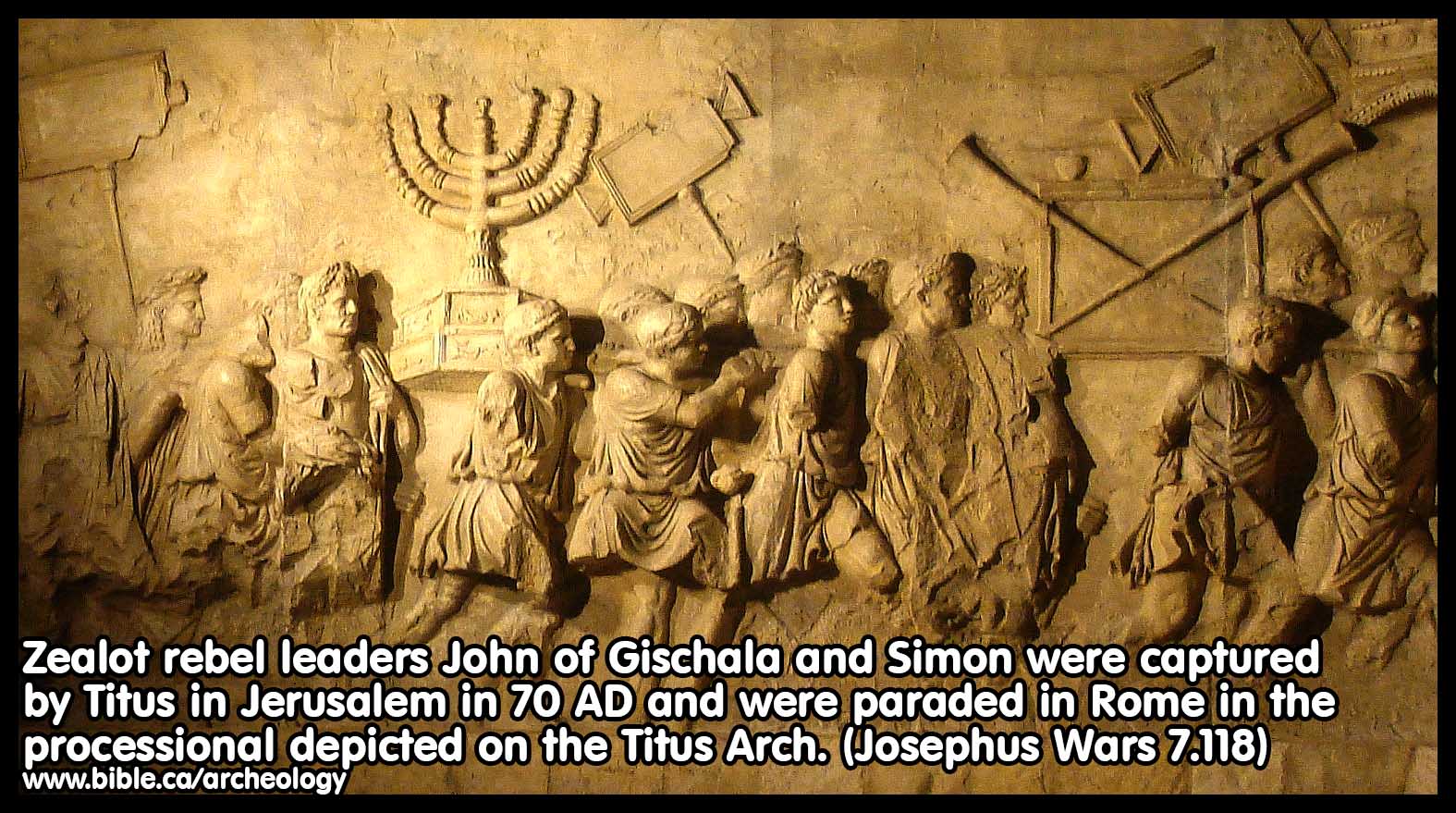
a. John and Simon are paraded through Rome with the spoils of the Temple: “as for the leaders of the captives, Simon and John, with the other seven hundred men, whom Titus had selected out of the rest as being eminently tall and handsome of body, he gave order that they should be soon carried to Italy, as resolving to display them in his triumph.” (Josephus Wars of the Jews 7.118)
b. “No attack had as yet been directed against this quarter; but famine was working terrible ravages among the crowded population. Those in command, however, refused to capitulate unless freedom to withdraw along with their wives and children were granted. These terms being withheld, a storm, after the usual preparations on the part of the Romans, took place. The resistance was feeble; the strong towers were hardly defended at all; Simon bar Giora and John of Giscala now thought only of their personal safety. In the unprotected city the Roman soldiers spread fire and slaughter unchecked (September 7, 70). Of those who survived also some were put to death; the rest were sold or carried off to the mines and amphitheatres. The city was levelled with the ground; the tenth legion was left behind in charge. Titus took with him to Rome for his triumphal procession Simon bar Giora and John of Giscala, along with seven hundred other prisoners, also the sacred booty taken from the temple, the candlestick, the golden table, and a copy of the Torah. He was slightly premature with his triumph; for some time elapsed, and more than one bloody battle was necessary before the rebellion was completely stifled. It did not come wholly to an end until the fall of Masada (April 73).” (Prolegomena to the History of Israel, J. Wellhausen, p538, 1885 AD)
Conclusion:
1. For an observant Jews like John of Gischala, he would live in a city with a synagogue which predated him to 78 BC.
a. That implies also that whatever Hasmonean (or Herodian) military garrison was in the area was located at Gush Halav, and not Meiron. Given “the significant quantities of Chalcolithic, Early Bronze, and Middle Bronze pottery, … significant quantities of Iron II material,” … “several nearly complete bowls [from the Persian period],” and the Hellenistic and Hasmonean coins and ceramics found there, Gush Halav had been a well-established settlement for centuries before the Hasmonean regime took over at the very end of the second century b.c.e. (Meyers et al. 1979: 35–36). Recognition of the presence of a Hasmonean military fortress at Gush Halav also gives us a more realistic, concrete sense of precisely how “the Hasmoneans” (Janneus, 78 BC) were attempting to “reintegrate distant segments of the population into the religious and political life of their kingdom” (Meyers et al. 1979: 36). It also reminds us that Galilee generally had not been under Jerusalem rule for eight centuries prior to 104 b.c.e. (Archaeology and the Villages of Upper Galilee: A Dialogue with Archaeologists, Richard Horsley, BASOR 297, p7, 1995 AD)
2. Two synagogues have been excavated at Gush Halav (Gischala)
a. The original synagogue which John of Gischala worshipped in, was constructed in 78 BC was located at the top of a hill and a church was built which destroyed much of the archeology.
b. A second later synagogue was built what reused the heart-shaped columns from the original synagogue on the hill.
3. See also: First Century Jewish Messianic Expectation: As witnessed in the Dead Sea scrolls.
By Steve Rudd 2017: Contact the author for comments, input or corrections
|
Jesus your messiah is waiting for you to come home! |
|
|
Why not worship with a first century New Testament church near you, that has the same look and feel as the Jewish Synagogue in your own home town. As a Jew, you will find the transition as easy today as it was for the tens of thousands of your forefathers living in Jerusalem 2000 years ago when they believed in Jesus the Nazarene (the branch) as their messiah. It’s time to come home! |
|
By Steve Rudd: Contact the author for comments, input or corrections.
Go to: Main Ancient Synagogue Start Page


